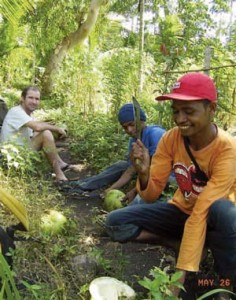| The hill tribes in the remote mountain regions are mostly subsistence farmers. In the mountains during the dry season there is mist and some rain so they are able to grow crops year round and produce a reasonable food supply. However transport costs are very high as roads are poor and few, so they must sell most of their produce locally. This means that very few dollars come into the district, leaving little or no money for school books and fees, purchasing medicines, tools or other necessary supplies.As a visitor trekking or cycling in Timor, whether you are in the mountains, Oecussi enclave on Atauro or Jaco Island you will need to hire a guide and buy accommodation and food. This greatly assists in rebuilding the local economy, following the scorched earth policy of the withdrawing Indonesian military.
Aid distribution and local guides
It is through links with local East Timorese in the remote areas that these trek notes have been developed. As a volunteer for CNRT (Council National Resistance Timor ) I first visited the country in late 1999. The CNRT leaders talked to volunteers about the needs of the people in the remote areas where many villages had been left devastated.
Back in Australia a group of us and Timorese Diaspora decided that where we could help most was with providing shelter. (After the rampages of the Indonesian military and Timorese militia there was very little shelter left. It was the wet season and people were dying from exposure.)
We drove our two four wheel drive vehicles and tandem trailers loaded with the materials for building the shelters from Melbourne to Darwin. |

ATAURO ISLAND SNACK
Along with seven tones of steel pipe purchased in Darwin all this was shipped across the Timor sea to Dili.
At the time the East Timorese had only one large truck, a six wheel drive troop carrier captured from the Indonesians. They lent us that truck. We took this with all our supplies on a military barge to Oecussi and then up into the remote mountains to house widows and children.Guides took us across rivers, over mountain passes and to isolated, ravaged villages. We delivered shelters, and in later years other donated goods such as clothing, cooking utensils and books to local leaders who organized their distribution.
Over the years since the first trips, these links with village leaders and guides have been maintained. They have generously shared their knowledge of local geography and culture. Exploring the remote areas with them has enabled the development of these trek notes. |